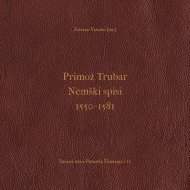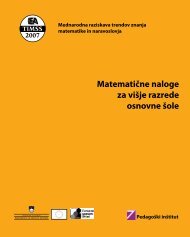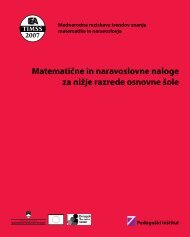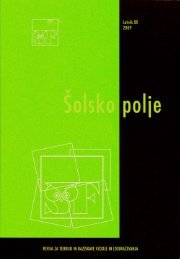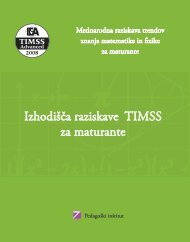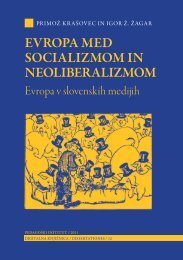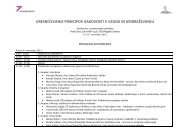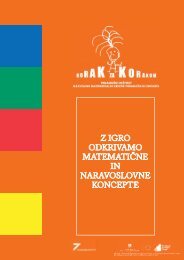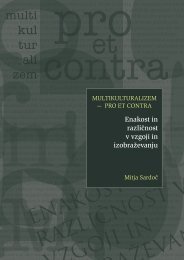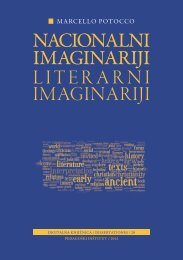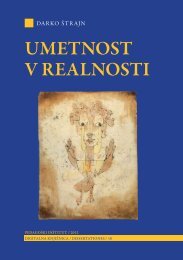62 ŠOLSKO POLJE LETNIK <strong>XX</strong> ŠTEVILKA 5/6These examples may sound kind of square and flat nowadays. But hereare a few Aristotelian topoi that could well be used in critical discourseanalysis (instead of just checking the possible arguments »against thebackground of the list of topoi«). They are not »common truths«, or »generallyaccepted probabilities«, but a kind of precepts for finding and testingthese »common truths« or »generally accepted probabilities«:»For philosophic purposes we must deal with propositions from thepoint of view of truth, but for purposes of dialectic, with a view to opinion.Propositions must always be taken in their most universal form.«(T. I. xiv. 30-31)»One commonplace is to look whether your opponent has assigned asan accident something which belongs in some other way.« (T. II. ii. 34-36)»Another commonplace is to make definitions both of the accidentand of that to which it belongs, either of both separately or one of them,and then see if anything untrue has been assumed as true in the definitions.For example, to see if it is possible to wrong a god, you must ask,what does ‘wrong’ mean?« (T. II. ii. 30-34)»Furthermore, if a term is used with more than one meaning and ithas been stated that it belongs to or does not belong to something, weought to demonstrate one of the several meanings if it is impossible todemonstrate both.« (T. II iii 23-26)It should be pretty clear by now, I think, that we can distinguish twoways in which Aristotle frames topoi in his Topics. Even more, topoi in theTopics would (usually) be twofold, they would consist of an instruction,and on the basis of this instruction a rule would be formulated:1) Instructions (precepts): »Check whether C is D.«2) Rules (laws): »If C is D, then B will be A.«Instructions would (usually) check the relations between the four predicables(definition, genus, property, accident), and upon this check up, akind of a rule would be formulated that could - applied to a certain subject-matter- serve as a general premise of an enthymeme.Topoi therefore serve as heuristic devices, and can be of three types:1) Some topoi instruct one to examine, for instance, whether »the contraryof A holds of the contrary of B«, if B is A is to be proved.2) Other topoi consist merely of such an introductory label and an exampleof the type of argument in question. Here the introductory label
TOPOI IN CRITICAL DISCOURSE ANALYSIS63is apparently meant to guide as associative process that might lead toan argument rather than to give a precise description of a premise tobe used in a rhetorical syllogism.3) A third group provides no logical analysis or characterization of a possibletype of argument. Aristotle occasionally acknowledges that he isdrawing on useful material he found in contemporary handbooks.What is especially important for our discussion here (i. e. the use of topoiin critical discourse analysis) is that though they were primarily meant tobe tools for finding arguments, topoi can also be used for testing givenarguments. Which seems to be a much more critical and productiveprocedure than testing hypothetical arguments »against the backgroundof the list of topoi«. But to be able to do that, DHA analysts should1) clearly (unequivocally) identify and formulate arguments andconclusions in a given discourse fragment, and2) show how (possible) topoi relate to these arguments.In the DHA works quoted in the first part of our article, neither of the twosteps was taken.This is how topoi were treated in the Topics. But when we turn fromthe Topics to the (later) Rhetoric, we are faced with the problem that theuse (and meaning) of topos in Aristotle’s Rhetoric is much more heterogeneousthan in the Topics. Beside the topoi which perfectly comply withthe description(s) given in the Topics, there is an important group of topoiin the Rhetoric, which contain instructions for arguments not of acertain form, but with a certain (concrete) predicate (for example,that something is good, honorable, just, etc.).In Rhetoric 1358a2-35 I.2 Aristotle distinguishes between general/common topoi on the one hand and specific topoi on the other. In thatsame chapter, he explains the sense of ‘specific’ by saying that some thingsare specific to physics, others to ethics, etc. But from chapter I.3 onhe makes us think that ‘specific’ refers to the different species ofrhetoric, so that some topoi are specific to deliberative, other toepideictic, and still others to judical speech. While he is inclined tocall the general or common topoi simply topoi, he uses several names forthe specific topoi (idiai protaseis, eidê, idioi topoi). Therefore, it may betempting to call the specific topoi ‘material’ and the common topoi ‘formal’.But in doing so we may easily overlook that some of the commontopoi (in chapters II.23-24) are not all based on those formal cate-
- Page 3:
VSEBINA LETNIK XX ŠTEVILKA 5/6 Z
- Page 7 and 8:
UVODNA NOTICAIgor Ž. ŽagarTole pi
- Page 9 and 10:
ZA KAJ GRE V KAD - PREGLEDZGODOVINE
- Page 11 and 12:
ZA KAJ GRE V KAD - PREGLED ZGODOVIN
- Page 13: ZA KAJ GRE V KAD - PREGLED ZGODOVIN
- Page 17 and 18: ZA KAJ GRE V KAD - PREGLED ZGODOVIN
- Page 19 and 20: ZA KAJ GRE V KAD - PREGLED ZGODOVIN
- Page 21 and 22: ZA KAJ GRE V KAD - PREGLED ZGODOVIN
- Page 23 and 24: ZA KAJ GRE V KAD - PREGLED ZGODOVIN
- Page 25 and 26: ZA KAJ GRE V KAD - PREGLED ZGODOVIN
- Page 27 and 28: DISKURZ: FOUCAULT, LACLAU TERZAPOPA
- Page 29 and 30: DISKURZ: FOUCAULT, LACLAU TER ZAPOP
- Page 31 and 32: DISKURZ: FOUCAULT, LACLAU TER ZAPOP
- Page 33 and 34: DISKURZ: FOUCAULT, LACLAU TER ZAPOP
- Page 35 and 36: DISKURZ: FOUCAULT, LACLAU TER ZAPOP
- Page 37 and 38: DISKURZ: FOUCAULT, LACLAU TER ZAPOP
- Page 39 and 40: DISKURZ: FOUCAULT, LACLAU TER ZAPOP
- Page 41 and 42: DISKURZ: FOUCAULT, LACLAU TER ZAPOP
- Page 43 and 44: DISKURZ: FOUCAULT, LACLAU TER ZAPOP
- Page 45 and 46: DISKURZ: FOUCAULT, LACLAU TER ZAPOP
- Page 47 and 48: DISKURZ: FOUCAULT, LACLAU TER ZAPOP
- Page 49 and 50: TOPOI IN CRITICAL DISCOURSE ANALYSI
- Page 51 and 52: TOPOI IN CRITICAL DISCOURSE ANALYSI
- Page 53 and 54: TOPOI IN CRITICAL DISCOURSE ANALYSI
- Page 55 and 56: TOPOI IN CRITICAL DISCOURSE ANALYSI
- Page 57 and 58: TOPOI IN CRITICAL DISCOURSE ANALYSI
- Page 59 and 60: TOPOI IN CRITICAL DISCOURSE ANALYSI
- Page 61 and 62: TOPOI IN CRITICAL DISCOURSE ANALYSI
- Page 63: TOPOI IN CRITICAL DISCOURSE ANALYSI
- Page 67 and 68: TOPOI IN CRITICAL DISCOURSE ANALYSI
- Page 69 and 70: TOPOI IN CRITICAL DISCOURSE ANALYSI
- Page 71 and 72: TOPOI IN CRITICAL DISCOURSE ANALYSI
- Page 73 and 74: TOPOI IN CRITICAL DISCOURSE ANALYSI
- Page 75 and 76: TOPOI IN CRITICAL DISCOURSE ANALYSI
- Page 77 and 78: University of Queensland, Centre fo
- Page 79 and 80: JOURNALISTIC (RE)PRODUCTION OF HIST
- Page 81 and 82: JOURNALISTIC (RE)PRODUCTION OF HIST
- Page 83 and 84: JOURNALISTIC (RE)PRODUCTION OF HIST
- Page 85 and 86: JOURNALISTIC (RE)PRODUCTION OF HIST
- Page 87 and 88: JOURNALISTIC (RE)PRODUCTION OF HIST
- Page 89 and 90: JOURNALISTIC (RE)PRODUCTION OF HIST
- Page 91 and 92: JOURNALISTIC (RE)PRODUCTION OF HIST
- Page 93 and 94: JOURNALISTIC (RE)PRODUCTION OF HIST
- Page 95 and 96: JOURNALISTIC (RE)PRODUCTION OF HIST
- Page 97 and 98: JOURNALISTIC (RE)PRODUCTION OF HIST
- Page 99 and 100: JOURNALISTIC (RE)PRODUCTION OF HIST
- Page 101 and 102: JOURNALISTIC (RE)PRODUCTION OF HIST
- Page 103 and 104: THE VOICE OF AN AGENDA-SETTINGAUTHO
- Page 105 and 106: THE VOICE OF AN AGENDA-SETTING AUTH
- Page 107 and 108: THE VOICE OF AN AGENDA-SETTING AUTH
- Page 109 and 110: THE VOICE OF AN AGENDA-SETTING AUTH
- Page 111 and 112: THE VOICE OF AN AGENDA-SETTING AUTH
- Page 113 and 114: THE VOICE OF AN AGENDA-SETTING AUTH
- Page 115 and 116:
THE VOICE OF AN AGENDA-SETTING AUTH
- Page 117 and 118:
THE VOICE OF AN AGENDA-SETTING AUTH
- Page 119 and 120:
THE VOICE OF AN AGENDA-SETTING AUTH
- Page 121 and 122:
THE VOICE OF AN AGENDA-SETTING AUTH
- Page 123 and 124:
THE VOICE OF AN AGENDA-SETTING AUTH
- Page 125 and 126:
THE VOICE OF AN AGENDA-SETTING AUTH
- Page 127 and 128:
THE VOICE OF AN AGENDA-SETTING AUTH
- Page 129 and 130:
THE VOICE OF AN AGENDA-SETTING AUTH
- Page 131 and 132:
THE VOICE OF AN AGENDA-SETTING AUTH
- Page 133 and 134:
THE VOICE OF AN AGENDA-SETTING AUTH
- Page 135 and 136:
‘68 KOT HKRATNA KRIZA EVROPSKEGAZ
- Page 137 and 138:
‘68 KOT HKRATNA KRIZA EVROPSKEGA
- Page 139 and 140:
‘68 KOT HKRATNA KRIZA EVROPSKEGA
- Page 141 and 142:
‘68 KOT HKRATNA KRIZA EVROPSKEGA
- Page 143 and 144:
‘68 KOT HKRATNA KRIZA EVROPSKEGA
- Page 145 and 146:
‘68 KOT HKRATNA KRIZA EVROPSKEGA
- Page 147 and 148:
‘68 KOT HKRATNA KRIZA EVROPSKEGA
- Page 149 and 150:
‘68 KOT HKRATNA KRIZA EVROPSKEGA
- Page 151 and 152:
‘68 KOT HKRATNA KRIZA EVROPSKEGA
- Page 153 and 154:
‘68 KOT HKRATNA KRIZA EVROPSKEGA
- Page 155 and 156:
‘68 KOT HKRATNA KRIZA EVROPSKEGA
- Page 157 and 158:
‘68 KOT HKRATNA KRIZA EVROPSKEGA
- Page 159 and 160:
POVZETKI/ABSTRACTSZA KAJ GRE V KAD
- Page 161 and 162:
POVZETKI / ABSTRACTS159NOVINARSKA (
- Page 163 and 164:
POVZETKI / ABSTRACTS161‘68 AS PAR
- Page 165 and 166:
AVTORJI/AUTHORSRuth WodakRuth Wodak
- Page 168 and 169:
166 ŠOLSKO POLJE LETNIK XX ŠTEV
- Page 170 and 171:
168 ŠOLSKO POLJE LETNIK XX ŠTEV
- Page 172:
ZAHVALARevija Šolsko polje izhaja



